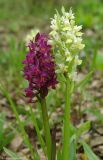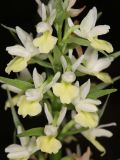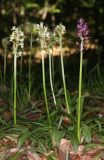Dactylorhiza romana ssp. georgica Описание таксона
определитель растений онлайн
Dactylorhiza romana ssp. georgica
Показать раздел
Изображения
Русскоязычные названия
Научные:
Систематика
   |
Dactylorhiza romana ssp. georgica Пальчатокоренник желтоватый |
| отдел | Magnoliophyta |
| класс | Liliopsida |
| порядок | Orchidales |
| семейство | Orchidaceae |
| род | Dactylorhiza |
| вид | romana |
| подвид | georgica |
В списке-первоисточнике это название считалось синонимом Dactylorhiza flavescens
Синонимы
* – отсутствует в списке-первоисточнике.
* – в списке-первоисточнике таксон имеет другой статус
Изображения
Показано с 1 по 30-е (30 из 120 найденных)
 |
Dactylorhiza romana ssp. georgica Цветущие растения. Краснодарский край, Туапсинский р-н, Главный Кавказский хр., окр. горы Семиглавая, высота 1400 м н.у.м., субальпийский луг. 19.05.2024. |
 |
Dactylorhiza romana ssp. georgica Цветущее растение. Краснодарский край, Туапсинский р-н, Главный Кавказский хр., окр. горы Семиглавая, высота 1400 м н.у.м., в соснах. 19.05.2024. |
 |
Dactylorhiza romana ssp. georgica Цветущее растение. Краснодарский край, м/о г. Новороссийск, вершина 429, остепнённый луг. 10.04.2024. |
 |
Dactylorhiza romana ssp. georgica Верхушка побега с соцветием. Краснодарский край, м/о г. Новороссийск, вершина 429, остепнённый луг. 10.04.2024. |
 |
Dactylorhiza romana ssp. georgica Цветущее растение. Краснодарский край, м/о г. Новороссийск, вершина 429, остепнённый луг. 10.04.2024. |
 |
Dactylorhiza romana ssp. georgica Верхушка побега с соцветием. Краснодарский край, м/о г. Новороссийск, вершина 429, остепнённый луг. 10.04.2024. |
 |
Dactylorhiza romana ssp. georgica Часть соцветия. Дагестан, Кумторкалинский р-н, хр. Нарат-Тюбе, криволесье из дуба и сосны по гребню, ок. 670 м выс., н. у. м. 26 апреля 2023 г. |
 |
Dactylorhiza romana ssp. georgica Соцветие. Краснодарский край, Мостовской р-н, хр. Малые Бамбаки, ≈ 1600 м н.у.м., субальпийский луг. 21.05.2022. |
 |
Dactylorhiza romana ssp. georgica Цветущее растение. Краснодарский край, Туапсинский р-н, Главный Кавказский хр., окр. горы Семиглавая, высота 1400 м н.у.м., субальпийский луг. 27.05.2023. |
 |
Dactylorhiza romana ssp. georgica Цветущее растение. Абхазия, Гагрский р-н, гора Мамдзышха, выс. 1810 м н.у.м., альпийский луг. 15.05.2021. |
 |
Dactylorhiza romana ssp. georgica Соцветие. Абхазия, Гагрский р-н, гора Мамдзышха, выс. 1810 м н.у.м., альпийский луг. 15.05.2021. |
 |
Dactylorhiza romana ssp. georgica Цветущее растение. Абхазия, Гагрский р-н, гора Мамдзышха, выс. 1810 м н.у.м., альпийский луг. 15.05.2021. |
 |
Dactylorhiza romana ssp. georgica Цветущее растение. Абхазия, Гагрский р-н, гора Мамдзышха, выс. 1798 м н.у.м., альпийский луг. 15.05.2021. |
 |
Dactylorhiza romana ssp. georgica Цветущее растение. Абхазия, Гагрский р-н, гора Мамдзышха, выс. 1798 м н.у.м., альпийский луг. 15.05.2021. |
 |
Dactylorhiza romana ssp. georgica Цветущие растения. Дагестан, Табасаранский р-н, окр. с. Татиль, буковый лес. 4 мая 2022 г. |
 |
Dactylorhiza romana ssp. georgica Цветущие растения. Дагестан, Табасаранский р-н, окр. с. Татиль, буковый лес. 4 мая 2022 г. |
 |
Dactylorhiza romana ssp. georgica Соцветие с цветками и завязавшимися плодами. Дагестан, Табасаранский р-н, окр. с. Татиль, буковый лес. 4 мая 2022 г. |
 |
Dactylorhiza romana ssp. georgica Цветущее растение. Дагестан, Табасаранский р-н, окр. с. Татиль, буковый лес. 4 мая 2022 г. |
 |
Dactylorhiza romana ssp. georgica Верхушка соцветия. Дагестан, Табасаранский р-н, окр. с. Татиль, буковый лес. 4 мая 2022 г. |
 |
Dactylorhiza romana ssp. georgica Цветущее растение. Дагестан, Табасаранский р-н, окр. с. Татиль, буковый лес. 4 мая 2022 г. |
 |
Dactylorhiza romana ssp. georgica Верхушка соцветия. Дагестан, Табасаранский р-н, окр. с. Татиль, буковый лес. 4 мая 2022 г. |
 |
Dactylorhiza romana ssp. georgica Цветущее растение. Дагестан, Табасаранский р-н, окр. с. Татиль, буковый лес. 4 мая 2022 г. |
 |
Dactylorhiza romana ssp. georgica Цветок. Дагестан, Табасаранский р-н, окр. с. Татиль, буковый лес. 4 мая 2022 г. |
 |
Dactylorhiza romana ssp. georgica Цветок. Дагестан, Табасаранский р-н, окр. с. Татиль, буковый лес. 4 мая 2022 г. |
Указания в Красных книгах (11)
Республика Адыгея (2011) — как Dactylorhiza flavescens
Республика Адыгея (2021) — как Dactylorhiza flavescens
Республика Дагестан (1998) — как Dactylorhiza flavescens
Краснодарский край (2007) — как Dactylorhiza flavescens
Краснодарский край (2017) — как Dactylorhiza flavescens
Ставропольский край (2002) — как Dactylorhiza flavescens
Ставропольский край (2013) — как Dactylorhiza flavescens
Туркменистан (1999) — как Dactylorhiza flavescens
Туркменистан (2011) — как Dactylorhiza flavescens
Туркменистан (2024) — как Dactylorhiza flavescens
Республика Южная Осетия (2017) — как Dactylorhiza flavescens
Веб-ресурсы
Гербарий | plant.depo.msu.ruПожаловаться
Сканы гербарных образцов (MW)
Краткое описание | molbiol.ruПожаловаться
Распространение | europlusmed.orgПожаловаться
Фото, распространение | powo.science.kew.orgПожаловаться
Фото, распространение | www.gbif.orgПожаловаться
Ссылки для публикаций
Dactylorhiza romana ssp. georgica (Klinge) Soó ex Renz & Taubenheim // Плантариум. Растения и лишайники России и сопредельных стран: открытый онлайн атлас и определитель растений. [Электронный ресурс] URL: https://www.plantarium.ru/page/view/item/12625.html (дата обращения: 14.03.2025).
Dactylorhiza romana ssp. georgica (Klinge) Soó ex Renz & Taubenheim // Plantarium. Plants and lichens of Russia and neighboring countries: open online galleries and plant identification guide. URL: https://www.plantarium.ru/lang/en/page/view/item/12625.html (accessed on 14 Mar 2025).
Растения и лишайники
Местообитания
Участник
Поиск
|
|
Обратная связь | Наверх |











